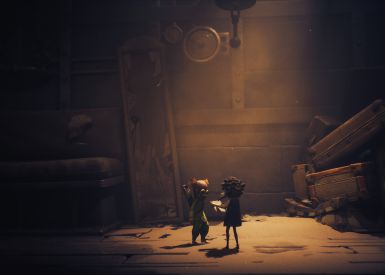The Legend of Zelda: Majora's Mask is one of the crowning examples of art in a video game. And it's a strong, solid Legend of Zelda game. But these two achievements are completely separate. Indeed, Majora's Mask succeeds as art in spite of its qualities as a game, and it succeeds as a game in spite of its narrative. It's a rare conundrum.
Every work of art arises from the interface between the elements that constitute it and the medium itself. A high fantasy novel consists of plot and characters portrayed in text. A Transformers movie is plot and characters portrayed in images and sounds (many, many sounds). A Zelda game is plot and characters portrayed through interactive images, text, sound and game mechanics. No matter the medium, any creative, narrative work comes down to characters and the actions they take. That's plain enough.
But the more artistic qualities of a work arise, not from the plot and characters, but from how they interface with and are expressed by the actual medium of a work. The themes of books like "Twilight" or "As I Lay Dying" would be very different if they were written in high Victorian prose, or in dactylic hexameter, even if the plots were unchanged. This is no revelation; form and function have always been hard to separate in the arts. It's no different for video games; interactivity and the mechanics of gameplay add in a few extra dimensions, just as film did a century ago, but the fundamentals haven't changed.
The greatest works of art arise when the mechanics of the form mesh tightly with what is being expressed through the form. It's why the best film adaptations of novels are often the least faithful. It's why Jurassic Park succeeds in the format of a blockbuster film better than it does as a novel, a novel written only so that it could be optioned and filmed. It's why translations on the whole are so difficult. It's why a quirky game like Katamari Damacy and a somber, even pretentious one like Shadow of the Colossus can both succeed artistically, even though they are at absolute cross-purposes with each other.
So much for the best works of art. Dreary things. Flawed works of art are much more compelling. The most interesting of these are works where the form and what is expressed through the form are both individually impressive, but fail to fit together. Alexander Pope's translation of Homer is the most obvious example; it was an excellent poem and it told an excellent story, but that story was not Homer, and it did not fit the poem's form. Cary Fukunaga's adaptation of Jane Eyre is another; it is entirely shot and presented as a monster movie, a vampire or werewolf movie, but it, of course, is neither. Sometimes, these flaws make a work better, sometimes worse, but always more interesting.
The Legend of Zelda: Majora's Mask is just such a flawed work of art.
Continue Reading:
Majora's Mask Part II: How The Narrative Undermines the Gameplay
Majora's Mask Part III: How the Gameplay Undermines the Narrative
Majora's Mask Part IV: The Gameplay and the Narrative in Harmony

















